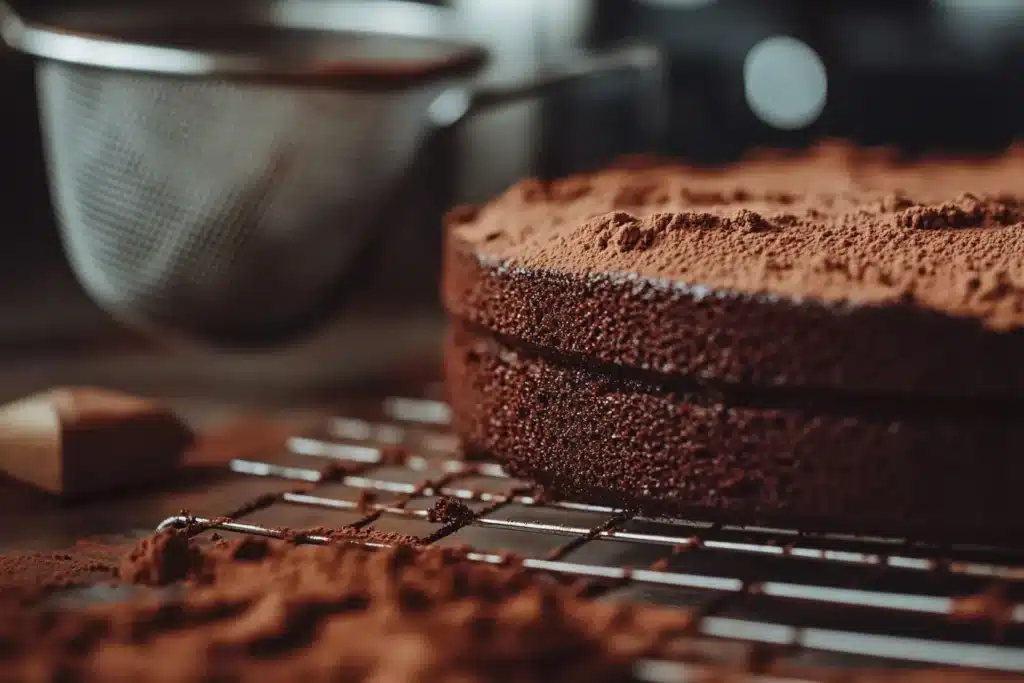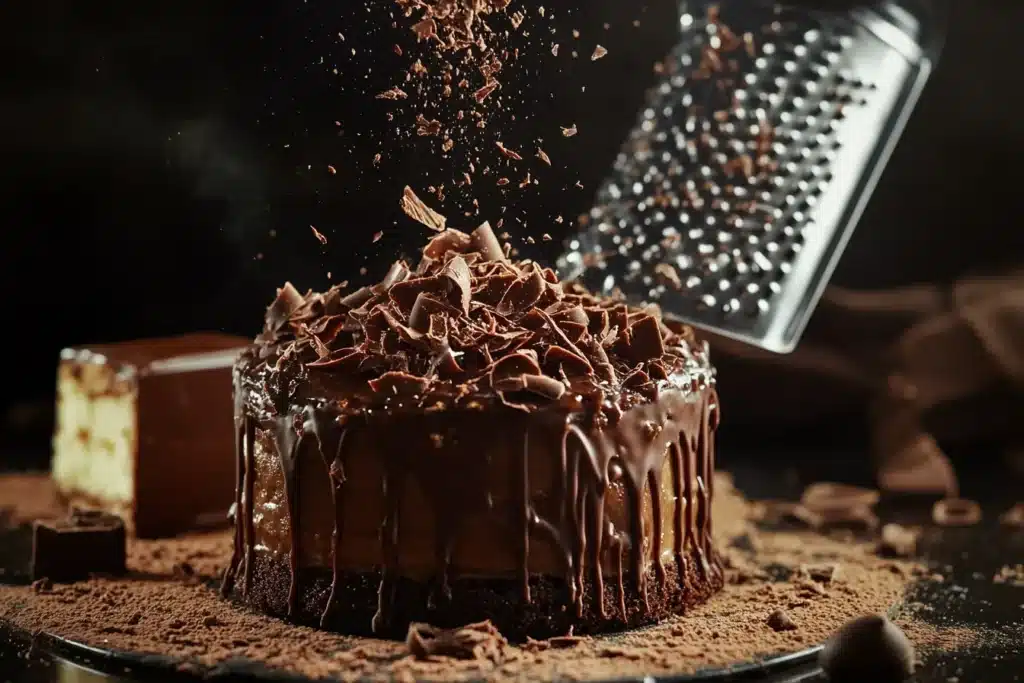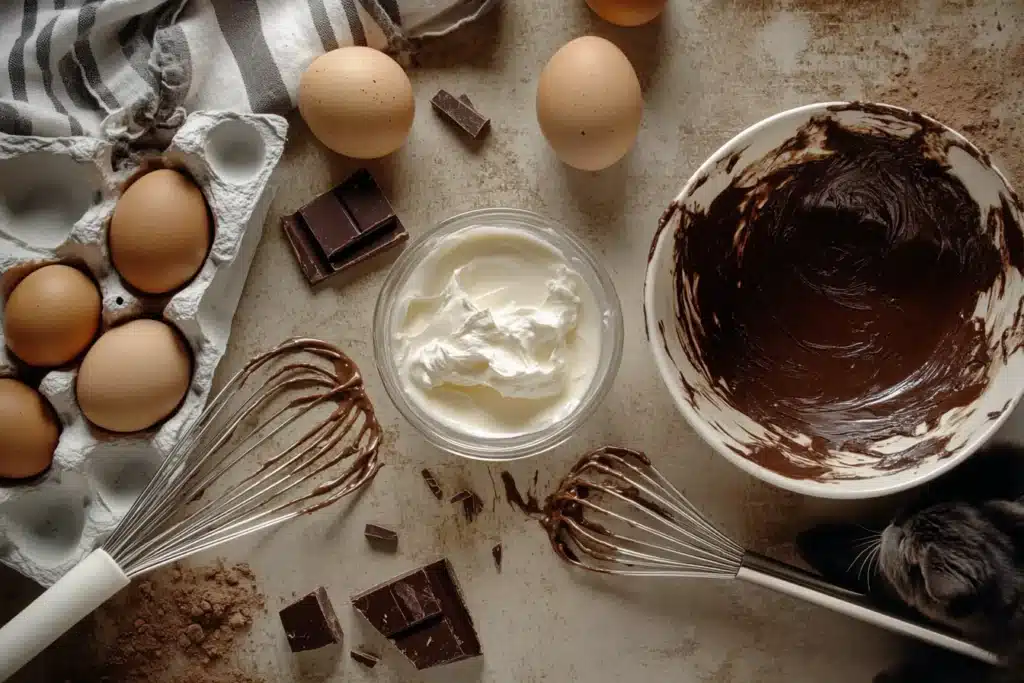Table of contents
Cake. Just the word conjures images of celebrations, comfort, and sheer deliciousness. But beyond that first bite, many of us wonder about the magic behind the layers. What makes a cake truly special? In this blog post, we’ll learn the answers to some burning cake questions. We’ll unravel the mysteries of triple chocolate cake, learn the world’s most beloved cake, define the term “triple chocolate,” and, finally, unlock the secret to a super moist cake that will make everyone swoon. So, grab a fork, maybe a glass of milk, and let’s get started!
What is Triple Chocolate Cake Made Of?
Ah, the magnificent triple chocolate cake! This decadent dessert is a symphony of chocolate in three glorious forms. It’s not just a cake; it’s an experience. But what exactly goes into creating this chocolate masterpiece? Let’s break it down.
The Foundation: Chocolate Cake Layers
The base of any great triple chocolate cake starts with the chocolate cake itself. While recipes vary, the core components generally include:
- Flour: This is the structure builder, providing the necessary foundation for the cake. All-purpose flour is commonly used, though some recipes may use cake flour for an extra tender crumb. However, cake flour, with its lower protein content, can result in a more delicate texture.
- Sugar: Sweetness is key, but it also contributes to the cake’s moisture and texture. Granulated sugar is the typical choice here. Also, different types of sugar can affect the final result; for instance, brown sugar adds a touch of molasses and extra moisture.
- Cocoa Powder: This is where the first layer of chocolate comes in! Unsweetened cocoa powder gives the cake its deep chocolate flavor and color. You can use Dutch-processed cocoa for a milder flavor or natural cocoa for a more intense taste.
- Eggs: They provide structure, richness, and help to emulsify the ingredients. In addition, they act as a binder, holding the cake together.
- Butter or Oil: Fat is crucial for a moist cake. You can choose to use softened butter for its flavor or vegetable oil for extra tenderness. For example, oil tends to create a more tender texture, while butter contributes a richer flavor.
- Baking Powder and/or Baking Soda: These are leavening agents that give the cake its rise and fluffy texture. Therefore, it’s important to use fresh leavening agents for the best results.
- Milk or Buttermilk: Adds moisture and helps to activate the leavening agents. Besides, buttermilk adds a subtle tang and contributes to a more tender crumb.
- Vanilla Extract: This enhances the overall flavor, adding depth and complexity. Similarly, other extracts, such as almond or coffee, can be used to compliment the chocolate.

The Second Layer: Chocolate Filling or Frosting
Here’s where the “triple” magic really starts to happen. After the cake layers are baked and cooled, they need that extra chocolate punch! This usually comes in the form of a rich chocolate ganache or a creamy chocolate frosting:
- Chocolate Ganache: This is made with heavy cream and chopped chocolate. It’s incredibly rich and decadent, perfect for a serious chocolate indulgence. The type of chocolate, whether dark, milk, or semi-sweet, is your choice! Of course, the quality of the chocolate used in a ganache directly affects the flavor.
- Chocolate Buttercream: This is a classic frosting made with butter, powdered sugar, cocoa powder, milk or cream, and vanilla extract. Again, you get to decide the type of chocolate, sometimes melted, is added for flavor. Additionally, you can use different types of chocolate, including semi-sweet, milk chocolate, or even white chocolate for a different twist.
The Crowning Glory: Chocolate Shavings or Curls
Finally, no triple chocolate cake is complete without a final layer of chocolate. This is often in the form of chocolate shavings, curls, or even chocolate chips sprinkled on top. It’s the final touch of chocolate perfection! It adds both texture and visual appeal and often, reinforces the “triple” effect.
- Chocolate Shavings: These are made by running a vegetable peeler along the edge of a block of chocolate. They create beautiful, delicate curls. While they are a classic decoration, you can also use other types of chocolate, like white or ruby chocolate, for added visual interest.
- Chocolate Curls: You can also use a knife to create beautiful curls from a bar of chocolate. Not only that, you can make different sized curls for visual appeal and variation.
- Chocolate Chips: Simple and effective, a scattering of chocolate chips adds a little extra texture and that classic chocolate taste. Above all, using high-quality chocolate chips can enhance the overall taste.
So, to summarize, a triple chocolate cake brings together chocolate cake, chocolate filling or frosting, and a decorative chocolate topping. It’s all about the chocolate, chocolate, chocolate! Now that we’ve learned what it’s made of, let’s journey to the next great cake question.

What is the Most Loved Cake in the World?
Identifying the single “most loved” cake in the world is like trying to pick a favorite star in the sky – there are just so many that shine brightly! Tastes are subjective and vary across cultures and personal preferences. However, there are some strong contenders that consistently top the popularity charts. Let’s learn some of these global favorites.
The Front Runners: Globally Popular Cakes
While preferences differ widely, there are some cakes that consistently appear in conversations about global favorites.
- Chocolate Cake: No surprise here! Chocolate cake is a universal love, taking various forms, from classic fudgy versions to light and airy ones. Its rich flavor, versatility, and ability to pair with almost anything makes it a winner. Also, chocolate cake can be made with different types of chocolate, making it highly customizable to personal preferences.
- Vanilla Cake: The OG of cakes! Vanilla cake’s simplicity is its charm. It’s often paired with various frostings and fillings, making it a canvas for endless flavor possibilities, from fruit fillings to chocolate ganache. Similarly, vanilla is a classic flavor that appeals to a wide range of tastes.
- Cheesecake: This rich and creamy dessert is a beloved classic with a history dating back to ancient Greece. It comes in various forms, like New York-style, Japanese, or Basque cheesecake, showing its versatility and wide appeal. For example, New York-style cheesecake is dense and rich, while Japanese cheesecake is light and airy.
- Red Velvet Cake: Its striking color, subtle chocolate flavor, and tangy cream cheese frosting make Red Velvet a favorite for special occasions and casual indulgence alike. Certainly, the visual appeal of a red velvet cake contributes to its popularity.
- Carrot Cake: Often dismissed but always adored, carrot cake, with its warm spices, moist texture, and cream cheese frosting, is a global comfort food. Additionally, carrot cake is a great option for people who like a slightly less sweet cake.
- Black Forest Cake: A German classic, this cake, with its chocolate sponge, whipped cream, and cherry filling, is a timeless favorite for many. Therefore, the combination of chocolate, cream, and cherries makes this a classic crowd-pleaser.
Regional Favorites: A Taste of the World
The beauty of cake is its variety, shaped by cultural preferences and ingredients.
- Tres Leches Cake (Latin America): A sponge cake soaked in three kinds of milk, this sweet and airy dessert is a regional favorite that’s gaining international popularity. In addition, the use of three different kinds of milk creates a unique texture and flavor.
- Opera Cake (France): This intricate cake, with its layers of almond sponge, coffee buttercream, and chocolate ganache, is a sophisticated treat. While it may seem daunting to make, the end result is a beautiful and delicious dessert.
- Lamingtons (Australia): These small sponge cakes coated in chocolate and rolled in coconut are an iconic Australian treat. Also, they are a popular choice for morning and afternoon tea.
- Matcha Cake (Japan): With its vibrant green color and earthy flavor, matcha cake is a popular choice in Japan and among matcha enthusiasts worldwide. Consequently, the unique flavor and color make it a popular dessert.
Why It’s Difficult to Crown One “Most Loved”
The difficulty in pinpointing one “most loved” cake lies in the sheer variety of options. Each cake has its fans and unique characteristics, catering to different tastes and cultural backgrounds. Ultimately, what one person considers the best, another might find less appealing. It’s a matter of personal preference. Of course, personal experiences and childhood memories often heavily influence our favorite desserts. Plus, let’s face it, your “most loved” cake might just be the one your grandma makes. That certainly holds a special place.
The takeaway here is that while no single cake reigns supreme universally, there are clear favorites that have won hearts worldwide. The beauty is in the diversity of choice and the joy that each one brings. And now, moving on from global favorites, let’s get into the delicious definition of “triple chocolate”.
What is Triple Chocolate?

Okay, we’ve talked about triple chocolate cake, but what exactly does “triple chocolate” even mean? It’s not a strict, legally defined term, but it generally refers to the incorporation of chocolate in three distinct ways in a single dessert. This approach amplifies that delicious cocoa flavor, creating an indulgent experience for chocolate lovers. Let’s unpack what these three layers often entail.
Three Ways of Chocolate: A Delicious Trinity
- Chocolate in the Base: This refers to the chocolate element within the cake or dessert itself. This could be:
- Cocoa Powder: As with the triple chocolate cake we discussed earlier, this adds depth of flavor, a bit of bitterness, and that classic chocolate hue. Since cocoa powder can vary in intensity, it’s important to choose one that suits your preference.
- Melted Chocolate: Some recipes include melted chocolate to intensify flavor and add a little extra richness to the mix. Similarly, the type of chocolate used will affect the overall flavor and texture.
- Chocolate in the Filling or Mix: This chocolate element is designed to enhance the overall chocolatey sensation. This can include:
- Chocolate Chips or Chunks: They add bursts of gooey chocolate throughout the dessert and a little extra texture. In addition, they melt beautifully in the oven, creating pockets of melty goodness.
- Chocolate Ganache: This rich mix of heavy cream and melted chocolate adds an incredibly decadent layer. Also, ganache can be made with different ratios of chocolate to cream, resulting in varying textures and consistencies.
- Chocolate Pudding: Sometimes, a layer of chocolate pudding is incorporated into a “triple chocolate” dessert. Furthermore, this adds an extra layer of moisture and a creamy texture.
- Chocolate in the Topping or Decoration: The final touch! The topping is designed to boost both the flavor and visual appeal. Some popular options include:
- Chocolate Shavings or Curls: These elegant touches add sophistication and yet another layer of chocolate flavor. While they look fancy, they are surprisingly simple to make at home.
- Chocolate Glaze: A shiny and sweet coating adds to the decadence. Therefore, it’s crucial to get the consistency right for optimal results.
Triple Chocolate Beyond Cake
While “triple chocolate” is most commonly associated with cake, the concept can be applied to various desserts, like:
- Brownies: Imagine a brownie made with cocoa powder, chocolate chips, and a chocolate ganache glaze – a truly triple chocolate experience! For example, triple chocolate brownies are incredibly decadent and satisfying.
- Cookies: A chocolate cookie base, filled with melted chocolate chunks, and dipped in melted chocolate is definitely worthy of the “triple” title. Later, you can add sea salt for a sweet and salty twist.
- Mousse: A chocolate mousse made with cocoa powder, melted chocolate, and topped with shavings? Yes, please. Additionally, mousse can be light or intensely rich, depending on the recipe.
The Allure of Triple Chocolate
Why do we love “triple chocolate” so much? It’s about maximizing the experience. Each layer of chocolate adds to the intensity and complexity of the flavor. It’s not just about sweetness; it’s about the multi-dimensional pleasure of having chocolate in different forms. For the true chocoholic, it’s the ultimate indulgence. We have defined triple chocolate, so now let’s move onto the final question: What’s the secret to a super moist cake?
What is the Secret to Super Moist Cake?
A dry cake is a sad cake. But don’t fret; achieving a super moist cake is less about magic and more about understanding the science of baking and using the right techniques. Several factors contribute to a cake’s moisture level, and we’re about to unlock those secrets.
The Role of Fats
Fats are crucial for a tender, moist crumb. They coat the flour proteins, hindering gluten development, which prevents the cake from becoming tough.
- Butter: Butter adds flavor and a slightly denser crumb. Always use softened butter for easy incorporation. However, be sure that your butter is at room temperature or it will be difficult to incorporate properly.
- Oil: Oil contributes to an exceptionally moist cake that stays tender for days. Vegetable oil or canola oil are good choices. Since oil is a liquid fat, it coats the flour more effectively than butter resulting in a more moist texture.

Moisture-Rich Ingredients
Several ingredients act as moisture magnets within the cake batter.
- Buttermilk or Sour Cream: These add a tang and contribute significantly to a moist, tender texture. The acidity also activates baking soda, promoting a good rise. Similarly, using them at room temperature will help them incorporate smoothly into the batter.
- Yogurt: Plain yogurt can be used as a substitute for buttermilk and adds a similar moisture level. Also, full-fat yogurt tends to create a more moist cake than low-fat.
- Applesauce: Unsweetened applesauce can be used to replace some of the oil, adding moisture and subtle flavor. Besides, applesauce provides a source of natural sweetness and fiber.
- Hot Liquids: Adding hot coffee or hot water to chocolate cakes is not just for blooming the cocoa; it also adds moisture to the batter. Consequently, this helps hydrate the cocoa and create a more moist crumb.
The Importance of Sugar
Sugar is not just about sweetness; it also helps in retaining moisture.
- Granulated Sugar: The most common choice for baking, it helps to tenderize the cake. Also, using a fine granulated sugar can result in a smoother cake texture.
- Brown Sugar: Adds a bit of molasses flavor and helps to create a more moist cake due to its higher moisture content. In addition, the molasses in brown sugar adds a depth of flavor.
Proper Mixing Techniques
Overmixing the batter can develop too much gluten, resulting in a tough cake.
- Don’t Overmix: Mix the batter until just combined. Stop mixing once the flour streaks disappear. Because overmixing develops too much gluten, it is important to mix only until just combined.
- Gentle Folding: When adding dry ingredients to wet, use a gentle folding motion to avoid deflating the batter. Earlier, we discussed the importance of not over mixing. This step is just as important.
Baking Considerations
Baking at the right temperature and for the correct time will impact the cake’s moisture.
- Correct Oven Temperature: Ensure your oven is preheated to the correct temperature and use an oven thermometer for accuracy. Certainly, an accurate oven temperature is crucial for consistent results.
- Don’t Overbake: Overbaking is the #1 culprit for dry cakes. Check for doneness with a toothpick – it should come out with a few moist crumbs attached, but not wet batter. While the toothpick test is reliable, it requires consistent testing and practice.
Post-Baking Techniques
The journey to a moist cake doesn’t end after baking.
- Cooling in the Pan: Allow the cake to cool in the pan for 10-15 minutes before inverting it onto a wire rack. This prevents it from sticking and helps to set its structure. Therefore, proper cooling in the pan is crucial to prevent cracking.
- Proper Storage: Once cooled, wrap the cake tightly in plastic wrap to keep it from drying out. Store in an airtight container at room temperature or in the refrigerator. Above all, proper storage is vital for maintaining the cake’s moisture.
- Simple Syrup: If you desire extra moisture, a simple syrup brushed onto the cooled layers will do the trick. Additionally, you can infuse the simple syrup with flavor extracts for extra depth.
By understanding these secrets, you can wave goodbye to dry cakes and bake super moist masterpieces every time. It really is all about the technique and ingredients. Finally, by combining these techniques with quality ingredients, you can create moist cakes every time.
Conclusion
So, there you have it! We’ve journeyed through the world of triple chocolate cake, discovered some of the most beloved cakes, defined “triple chocolate,” and uncovered the secrets to a perfectly moist cake. Baking is a science, but it’s also an art form. With a little knowledge and practice, you can bake cakes that not only look amazing, but also taste divine. So, go on, get baking! Try these new-found techniques and keep experimenting with flavors. After all, the best cake is the one that brings joy to those who make and enjoy it.

